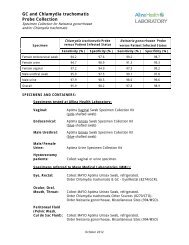Human (Granulocytic) Anaplasmosis (HGA ... - Allina Health
Human (Granulocytic) Anaplasmosis (HGA ... - Allina Health
Human (Granulocytic) Anaplasmosis (HGA ... - Allina Health
Create successful ePaper yourself
Turn your PDF publications into a flip-book with our unique Google optimized e-Paper software.
Your Pets<br />
A study from Austria showed no increased seroprevalence for Anaplasma phagocytophilum in<br />
cat or dog owners compared to non-pet owners, suggesting that pets are not a likely source<br />
of infection. In Europe and possibly in Washington state, transmission of Babesia divergens<br />
by Ixodes ricinus to humans has been reported.<br />
More About Ixodes scapularis (Deer Tick, Blacklegged Tick):<br />
Reservoir hosts for <strong>HGA</strong> in the United States of America are the white-footed mouse<br />
(transient bacteremia of 1-4 weeks), other small mammals, and the white-tailed deer<br />
(persistent subclinical infection vs merely supplying the food source). <strong>Human</strong>s are infected<br />
with tick-borne diseases when they come into contact with the tick vector in reservoir animal<br />
habitats. Peak tick activity is April through September.<br />
High risk counties in Minnesota include the eastern two-thirds of the state, in the<br />
approximate mid-portion, in a swath oriented from northwest to southeast extending to the<br />
St. Croix River region.<br />
The ticks are found in wooded and brushy areas but may reside in your own back yard,<br />
especially if you live adjacent to woods or have abundant brush or leaf litter in your yard.<br />
Ixodes scapularis life cycle<br />
Engorged Ixodes scapularis tick<br />
Adult ticks are approximately 1/8 inch long. Nymphs are slightly less than 1/16 inch long.<br />
Typically the tick must be attached for at least 12-24 hours in order to transmit the bacteria<br />
(although this may be shorter for <strong>HGA</strong>). Not all ticks carry the culprit organisms. Additional<br />
photographs of the deer tick are available on CDC and MDH web sites.<br />
For information on preventing tick-borne disease and how to remove ticks, visit the MDH web<br />
site<br />
10
















